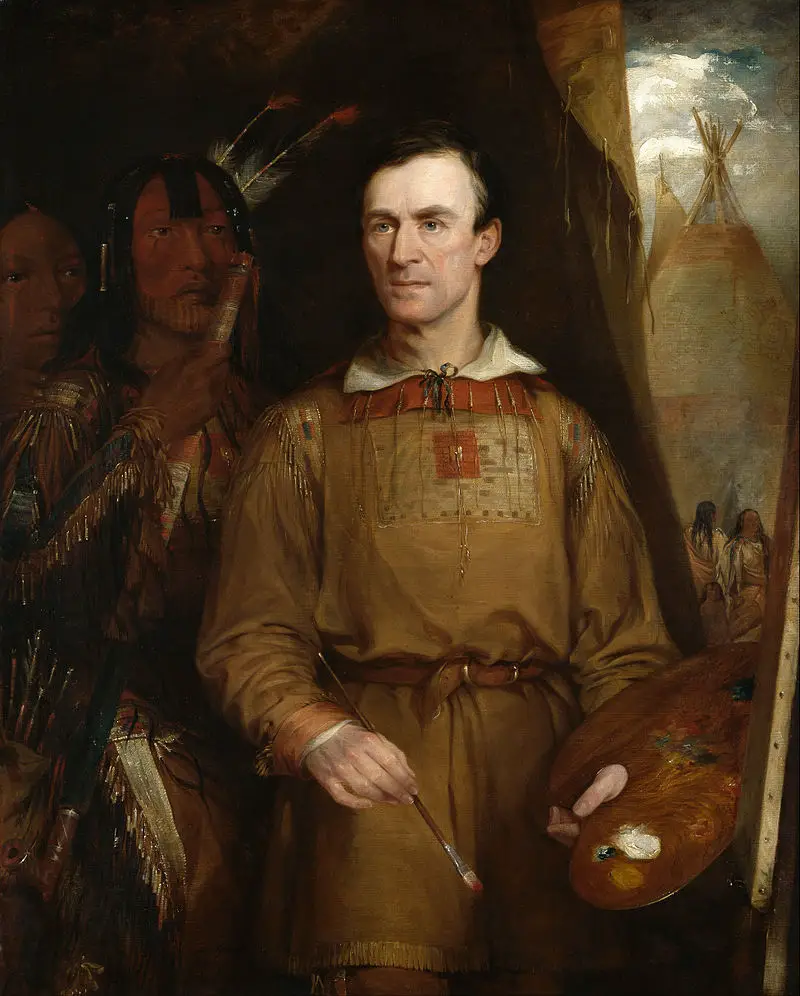George Catlin
Born: 1796
Place of Birth: Pennsylvania
Died: 1872

George Catlin was an artist who focus exposed the beauty, mystery, and culture of Native Indians in America. He devoted his life to bringing attention to America’s “vanishing race” and traveled the country visiting over fifty tribes. He chronicled his trips in a series of books and had the hope that he could expose the beauty of the customs of the Native Indians and change the preset prejudices that existed in North, Central, and South America. Catlin established the first Native Indian Art Gallery and inspired other artists that came after him.
- Born in Wilkes-Barre, Pennsylvania, Catlin was educated to be a lawyer. His life changed when he went on a diplomatic mission in 1830 with General William Clark and entered the territories of the Native Americans in the area. He set up his base in St. Louis, Missouri and from 1830-1836 he visited around fifty Native Indian tribes. He spent weeks among some of the tribes that had never come into contact with any of the Europeans. His visits included the tribes of the Omaha, Pawnee, and Ponca and then later on to the Mandan, Crow, Cheyenne, Blackfeet, and Assiniboine. His talent for painting was exposed in the vivid portraits of Native Indian life. He continued his adventure by visiting the Great Lakes region and Florida, resulting in a collection of over 500 paintings and an incredible artifact collection.
- Catlin’s idea was to put together the artifacts and paintings and open an Indian Gallery. Interest in his work allowed him to give public lectures and speeches and tell his stories about his life with the Native Indians. Catlin took his Indian Gallery on tour to many of the major cities in America. He chose the presentation of the artwork so that they hung side-by-side as well as one above another one in what was known as “salon style.”
- Catlin faced financial problems when the touring gallery didn’t attract enough attention and money to pay the bills. He had contacted the U.S. government in hopes that they would buy the paintings and artifacts but they rejected his request. Interest in Native Indians was growing in Europe so Catlin took the works for a tour of the capitals of Europe in 1839.
- By this time Catlin had become somewhat of a showman to get crowds interested and he presented the collection in London, Paris, and Brussels. Charles Baudelaire, a French critic stated: “M. Catlin has captured the proud, free character and noble expression of these splendid fellows in a masterly way.”
- Financial debts kept increasing for Catlin and he was forced to sell some of his work to Joseph Harrison, an industrialist, where he stored them in a Philadelphia warehouse. With little left, Catlin began a new group of paintings that was called the “Cartoon Collection.”
- Catlin transformed his art into over 300 engravings an published a book in 1841 called “Manners, Customs, and Conditions of the North American Indians.” The two volume series was followed by another publication called “Catlin’s North American Indian Portfolio” that included 25 plates and yet another one in 1848 called “Eight Years’ Travels and Residence in Europe.”
- His desire to explore took him to South and Central America from 1852-1857 and when he returned he continued to explore the western part of America. He published two more books in 1868 and 1909 that included all of the stories from those adventures.
- Catlin was invited to Washington, D.C. by Joseph Henry, who was the Smithsonian Museum’s first secretary. Catlin worked in a studio in the Smithsonian “Castle” until he died. Almost the entire collection that Catlin had was eventually donated to the Smithsonian Institute. There are around 700 of his sketches that in the New York City’s American Museum of Natural History.
Q&A:
What profession did George Catlin go to school for?
Lawyer
What situation caused a complete change in George Catlin’s life?
A diplomatic mission in 1830 with General William Clark
How many Native Indian tribes did George Catlin visit?
Over 500
Besides North American, what other places did George Catlin go to explore Natives?
South and Central America
Who did George Catlin try to sell all of the paintings and artifacts to?
The U.S. government
Where did almost all of the paintings finally end up after George Catlin’s death?
Smithsonian Institute



